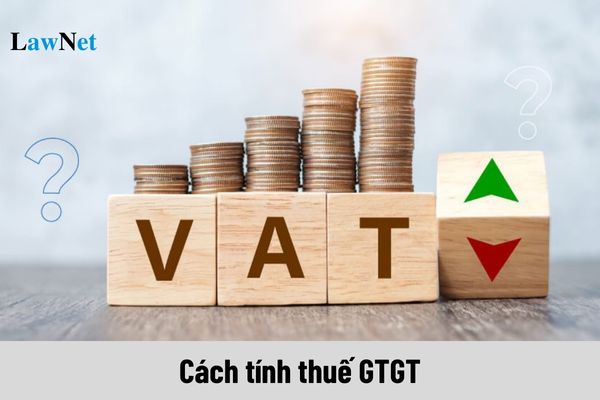What are VAT calculation methods in Vietnam?
What are VAT calculation methods in Vietnam?
According to the provisions of the Law on Value Added Tax 2008 and current documents, VAT is currently calculated using 02 methods:
- Credit method
- Method of calculation of tax based directly on added value.
In principle, the general formula for calculating VAT is as follows:
VAT = Taxable Price x VAT Rate
However, to be suitable for each entity subject to VAT, the calculation of VAT will differ when applying the 02 VAT calculation methods.

What are VAT calculation methods in Vietnam? (Image from Internet)
How to calculate VAT using the method of calculation of tax based directly on added value in Vietnam?
Based on Article 11 of the Law on Value Added Tax 2008 (amended and supplemented by Clause 5, Article 1 of the Amended Law on Value Added Tax 2013), the regulation on calculating VAT using the method of calculation of tax based directly on added value is as follows:
- The VAT payable under the method of calculation of tax based directly on added value is equal to the added value multiplied by the VAT rate applicable to the buying, selling, processing of gold, silver, and precious stones.
- The added value of gold, silver, and precious stones is determined by the payment price of sold gold, silver, and precious stones minus the payment price of purchased gold, silver, and precious stones.
(1) The VAT payable by the method of calculation of tax based directly on added value is equal to the percentage rate multiplied by the revenue applicable to:
- Enterprises, cooperatives with annual revenue below the one billion VND threshold, except for cases of voluntary registration for the credit method as stated in Clause 2, Article 10 of the Law on Value Added Tax 2008.
- Households, individual businesses.
- Foreign organizations and individuals doing business without a permanent establishment in Vietnam but generating revenue in Vietnam that have not fully implemented accounting, invoice, and document policies, except for foreign organizations and individuals providing goods and services for oil and gas exploration, development, and exploitation activities, paying tax by the credit method deducted and filed by the Vietnamese side.
- Other economic organizations, except for cases registering to pay tax by the credit method as stated in Clause 2, Article 10 of the Law on Value Added Tax 2008.
(2) The percentage rate for VAT calculation is specified as follows:
- Distribution, supply of goods: 1%.
- Services, construction without materials: 5%.
- Manufacturing, transportation, services with goods, construction including materials: 3%.
- Other business activities: 2%.
How to calculate value-added tax by the credit method in Vietnam?
Pursuant to Article 10 of the Law on Value Added Tax 2008 (amended by Clause 4, Article 1 of the Amended Law on Value Added Tax 2013), the regulation is as follows:
credit method
1. The credit method for value-added tax is specified as follows:
a) The value-added tax payable by the credit method is equal to output VAT minus deductible input VAT;
b) The output VAT equals the total value-added tax of goods and services sold as recorded on the VAT invoice.
The value-added tax of goods and services sold recorded on the VAT invoice equals the taxable price of taxable goods and services sold multiplied by the VAT rate of those goods and services.
In case of using documents with the payment price that already includes VAT, the output VAT is determined by the payment price minus the taxable value added price determined according to point k, Clause 1, Article 7 of this Law;
c) The deductible input VAT equals the total value-added tax recorded on the VAT invoice for purchased goods and services, documents for VAT payment on imported goods, and meets the conditions specified in Article 12 of this Law.
2. The credit method applies to business establishments that fully implement accounting, invoice, and document policies in accordance with the laws on accounting, invoices, and documents including:
a) Business establishments with annual revenue from sales of goods and provision of services from one billion VND or more, except for households and individual businesses;
b) Business establishments voluntarily registered to apply the credit method, except for households and individual businesses.
3. The Government of Vietnam will provide detailed regulations for this Article.
The credit method for value-added tax is as follows:
- The VAT payable by the credit method is equal to output VAT minus deductible input VAT;
- The output VAT equals the total value-added tax of goods and services sold as recorded on the VAT invoice.
The value-added tax of goods and services sold recorded on the VAT invoice equals the taxable price of taxable goods and services sold multiplied by the VAT rate of those goods and services.
In cases where documents record the payment price as including VAT, the output VAT is determined by the payment price minus the taxable value added price determined according to the provision at point k, Clause 1, Article 7 of the Law on Value Added Tax 2008;
- The deductible input VAT equals the total value-added tax recorded on the VAT invoice for purchased goods and services, documents for VAT payment on imported goods, and meets the conditions specified in Article 12 of the Law on Value Added Tax 2008.
Note: The credit method applies to businesses fully complying with accounting, invoice, and document policies as stipulated by laws on accounting, invoices, and documents, including:
- Business establishments with annual revenue from sales of goods and the provision of services from one billion VND or more, except for households and individual businesses;
- Business establishments voluntarily registered to apply the credit method, except for households and individual businesses.

